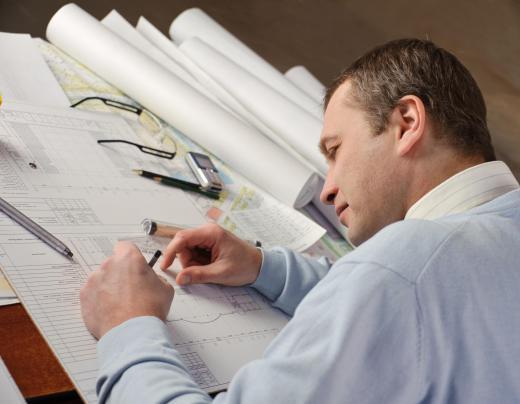What Is a Girt?
 Mary McMahon
Mary McMahon
A girt is a structural component that provides lateral support to the walls of a building. Girts can be found in structures of all sizes and may be made from wood, steel, concrete, and other materials depending on the nature and specifications of the project. These structural braces are installed early in the framing process to take lateral loads and distribute them safely. As the building goes up, these and other supports brace the structure and provide a framework for cladding and other components.
Also known as a sheeting rail, the girt runs horizontally through the wall paneling. Girt size and shape can vary, and these structural members may need to be adjusted to accommodate doors and windows. Around openings in the building, care must be taken with structural supports to avoid the creation of a weak point that might make the building vulnerable to damage.

Construction crews attach girts to critical vertical structural supports, using appropriate hardware and bracing for the application. Building codes may specify the size of structural supports and the type of hardware to use on the basis of building size and purpose. An engineer or architect can have additional input into this part of the construction process, as can an experienced contractor familiar with the distribution of loads in finished structures.

Bolting the girts in place can stabilize a structure and allows for the next stages of construction, like putting in non-load bearing walls, installing plumbing, electric, and other systems, and cladding the building to protect it from the elements. A girt should not be visible in the finished design, although it can be located with the use of devices like stud finders, or by eyeballing structural walls and estimating approximate location on the basis of building conventions and the building's history.
Like other structural supports, a girt cannot be removed without potentially serious consequences. In the event structural members need to be replaced or moved because the walls in the building need to shift to accommodate a new use, a structural engineer needs to supervise the process. Workers typically start by installing redundant bracing to take over the load. Next, they open up the structural wall and carefully remove components, taking note of any unusual events in case they need to stop and reassess. Once finished, they can replace the damaged components or move the wall to a new location, as long as it has been approved by an architect.
AS FEATURED ON:
AS FEATURED ON:












Discussion Comments
@SkyWhisperer - Yeah, if you’re just hanging up pictures you can just nail into the drywall like you were going to do originally.
But if it’s anything heavy you’re better off locating the precise studs. The stud finders are relatively cheap too and you can find them in any home improvement store.
We had to hang up a smart white board in one of the suites at work. My instinct would have been just to pound away at the wall with the nail, at any old location, and then hang the board up.
It’s a good thing they didn’t give me the hammer.
The manager told me we had to nail into the studs not into the drywall. We started first feeling around for where the studs were but he decided to settle on a more precise approach.
He had this digital stud finder which found the exact location of the studs; we marked the points, nailed in those locations and hung up the white board. It was picture perfect.
Honestly, I had never heard of a stud finder prior to this, but it made sense after we used it.
Post your comments